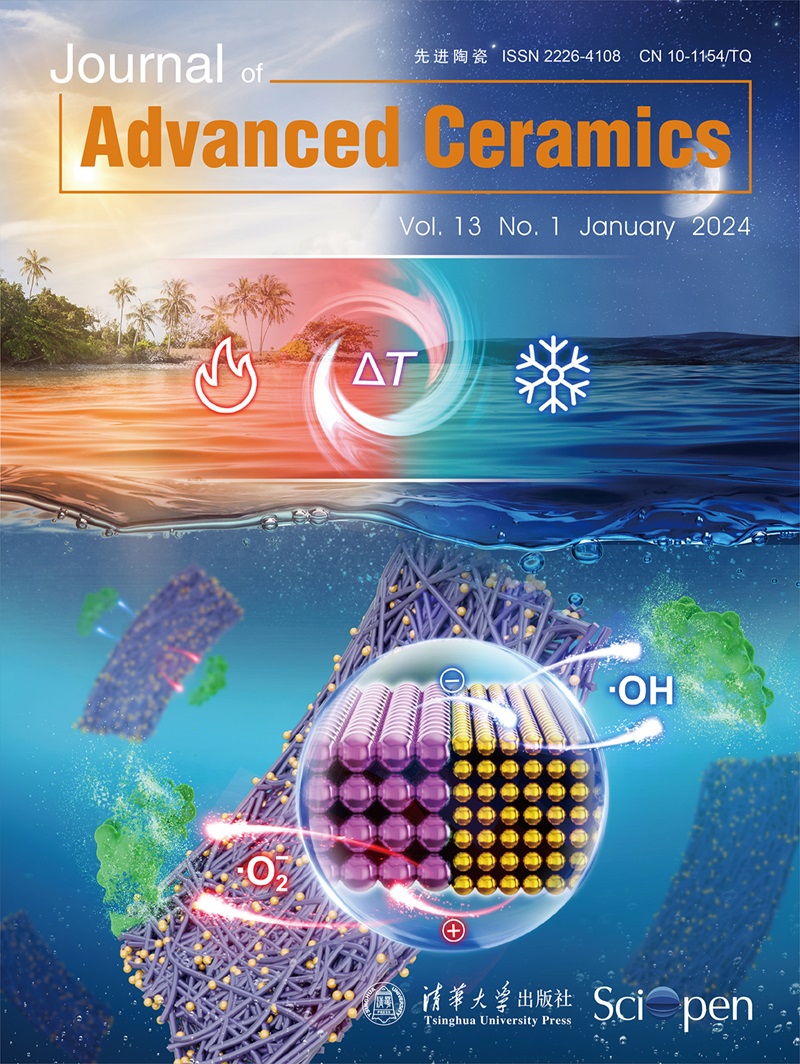内置纳米孔ZnO棒的增强压电催化作用
IF 16.6
1区 材料科学
Q1 MATERIALS SCIENCE, CERAMICS
引用次数: 0
摘要
长期以来,提高压电催化效率的策略主要集中在压电光耦合和异质结的构建上。然而,如何在单一材料中增强压电催化性能是一个挑战。本文利用单晶ZnO棒内嵌的纳米孔形成应力来增强压电催化效率。具有内置纳米孔的ZnO棒(多孔ZnO NRs)降解染料的压电催化效率约为无内置纳米孔ZnO棒(ZnO NRs)的1.7倍。与ZnO NRs相比,孔洞ZnO NRs的x射线衍射峰和拉曼峰出现蓝移,表明孔洞ZnO NRs中存在拉应力。多孔ZnO纳米粒子的压电系数d33提高了1.92倍,引发了压电催化性能的放大。此外,多孔ZnO纳米孔径的压电电流、载流子寿命和扩散长度均大于ZnO纳米孔径。这些因素都有助于提高多孔ZnO NRs的压电催化效率。本研究表明,内置纳米孔的诱导应力方法是提高单晶ZnO棒压电催化效率的一种有前途的策略。本文章由计算机程序翻译,如有差异,请以英文原文为准。
Enhanced piezo-catalysis in ZnO rods with built-in nanopores
Strategies to improve the efficiency of piezoelectric catalysis have long focused on piezo-optical coupling and the construction of heterojunctions. However, it is a challenge to reinforce the performance of piezoelectric catalysis in a single material. Herein the built-in nanopores in single-crystal ZnO rods are employed to form stress to intensify the piezo-catalytic efficiency. The piezo-catalytic efficiency of ZnO rods with built-in nanopores (holey ZnO NRs) for degrading dyes was about 1.7 times that of ZnO rods without built-in nanopores (ZnO NRs). The X-ray diffraction and Raman peaks of holey ZnO NRs appeared blue-shifted in comparison to ZnO NRs, uncovering the existence of tensile stress in holey ZnO NRs. The piezoelectric coefficient d33 of holey ZnO NRs increased by 1.92 times, triggering the amplification of piezoelectric catalytic property. Additionally, the piezoelectric current, carrier lifetime, and diffusion length of holey ZnO NRs were larger than that of ZnO NRs, respectively. These factors all contribute to the enhanced piezoelectric catalytic efficiency of holey ZnO NRs. This work demonstrates that the method of induced stress with built-in nanopores is a promising strategy for improving the piezoelectric catalytic efficiency of single-crystal ZnO rods.
求助全文
通过发布文献求助,成功后即可免费获取论文全文。
去求助
来源期刊

Journal of Advanced Ceramics
MATERIALS SCIENCE, CERAMICS-
CiteScore
21.00
自引率
10.70%
发文量
290
审稿时长
14 days
期刊介绍:
Journal of Advanced Ceramics is a single-blind peer-reviewed, open access international journal published on behalf of the State Key Laboratory of New Ceramics and Fine Processing (Tsinghua University, China) and the Advanced Ceramics Division of the Chinese Ceramic Society.
Journal of Advanced Ceramics provides a forum for publishing original research papers, rapid communications, and commissioned reviews relating to advanced ceramic materials in the forms of particulates, dense or porous bodies, thin/thick films or coatings and laminated, graded and composite structures.
 求助内容:
求助内容: 应助结果提醒方式:
应助结果提醒方式:


